|
 |
|
Appendix 4. The Houses
and People in Bush Street in 1911 |
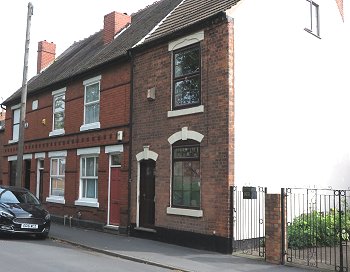 |
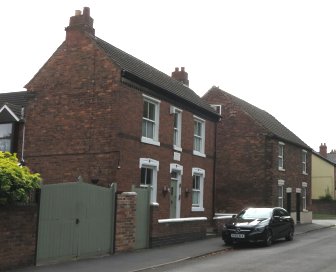 |
| While we were trying to find the location of Green Dairy in Bush
Street we photographed the first seven cottages in the street which
all still had their original frontages. |
| On the 1911 census these comprised Nos. 1, 2 & 3 Church View
Cottages, No.1 Bush Street, Green Cottage, Nos.2 & 3 Bush Street. We
discovered that No.4 Bush Street had disappeared under the turn off
to Bowling Green Crescent when the vicarage was demolished.
Nos.1,2,3 and 4 Bush Street were all shown on the 1885 OS Map and
were built around 1851. Church View Cottages did not appear on the
1903 OS map, so were built between 1903 and 1911. Unfortunately the
name tile on the front has no date The date tile on Green Cottage
gives us 1892 as the build date. Strangely Green Cottage does not
appear on the 1901 census. |
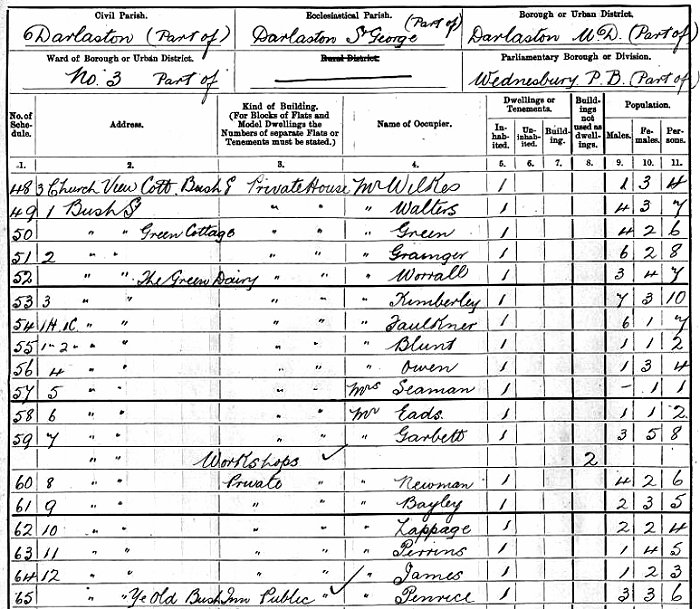
The
1911 summary census return for Bush Street, from the third Church
View Cottage as far as Ye Old Bush Inn Public House. |
| We can see who
was head of the household, and how many males and females lived in
each house.
On this summary census return we can see The Green Dairy between
nos. 2 and 3 Bush Street. Another useful source was a memoir on the historywebsite.co.uk
History of Darlaston written by Alice Hall which described life at
No.4 Bush Street, a typical 2 up/2 down cottage, and tells us about
the Green Dairy around 1914:
| No. 4 Bush Street had
two bedrooms and the family
were Granddad Owen (also
known as Captain Owen),
Granny Owen, their daughter,
her husband, their
granddaughter Florence
(known as Floss) and me,
plus two men lodgers.
There was one room
downstairs with a back
kitchen which flooded every
time it rained. Upstairs
there was a four poster
where Granny Owen and her
granddaughter Floss slept at
the top and I slept at the
bottom. Floss's mother and
father slept in the other
bedroom and Granddad Owen
and the two lodgers slept on
chairs downstairs.
They cooked on the fire and washed in bucket or bowl of cold water
which was fetched from the one outside tap, shared by the other two
houses in the yard. St George's Church, with its very overgrown
churchyard, was opposite.
There was a family called Jones who lived
in the Dairy, two doors down from us. This house is still there now,
no longer a dairy but called 'The Dairy's Still'. Mr Jones, an old
gentleman, used to come into the street with a big ear-trumpet. He
would put the trumpet to his ear, listen and say "Them's
over" (meaning the German
planes!) I remember sitting
on the gutter very late at
night and listening for the
zeppelins. |
|
|
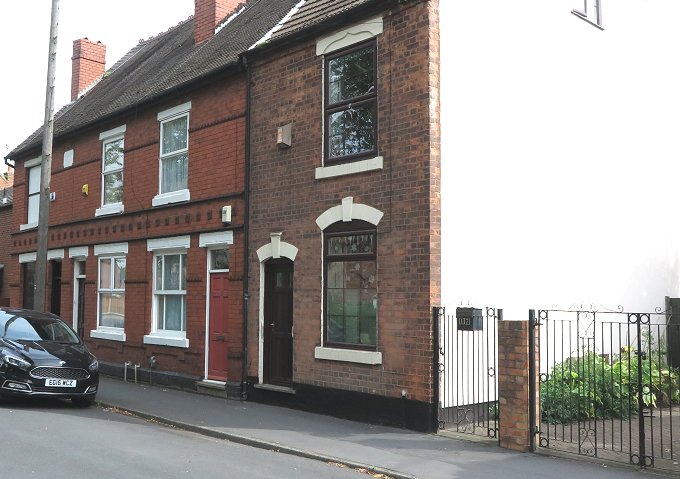
This photo shows the frontages of the three Church View Cottages
built between 1903 and 1911 and not on the 1903 map.
These butted up against No.1 Bush Street, a 2 up/2 down house built
around 1850 and which originally had a second house behind it, still
occupied on the 1901 census. |
|
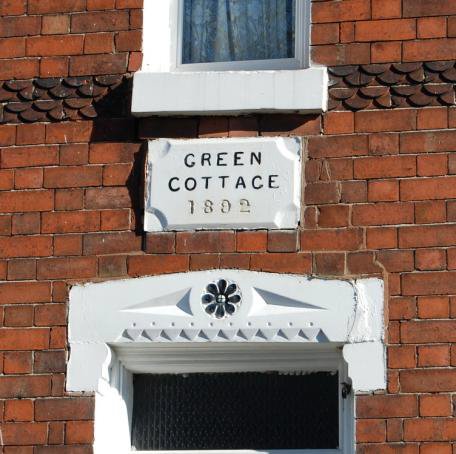 |
Below is a photo of Green Cottage with its double gate access to a
sizeable yard. The build name and build date of 1892 is on the tile
over the front door. |
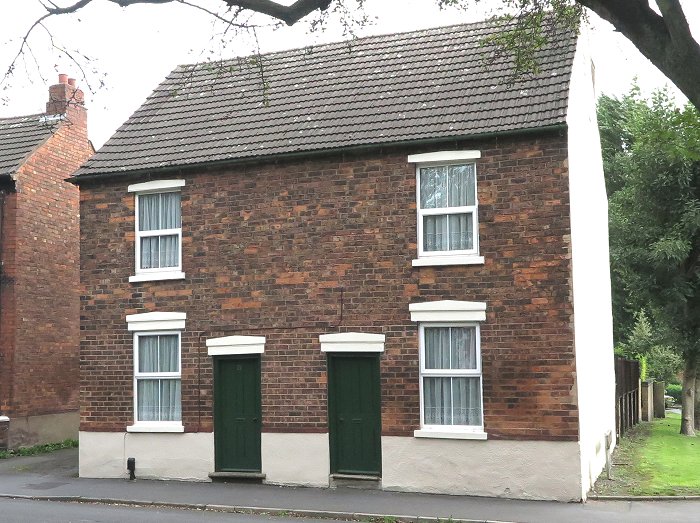
This is a photo of Nos.2 and 3 Bush Street next to Green Cottage and
on the corner of Bowling Green Close. In 1911
there was a large court next to these cottages which included No.4
Bush Street fronting on to the street. |

This photo shows the alleyway between Green Cottage and Nos.2 & 3
Bush Street. The alley leads to Green Dairy. |
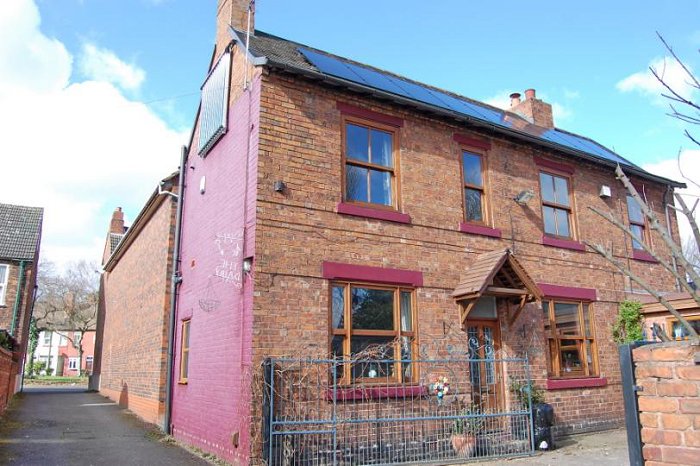
“The Dairy”, looking back up the alleyway across The Green to the
houses ( Jubilee Buildings) on the other side of the main road. The
infill between Green Cottage and the Dairy is modern brick. (Photo
Dennis Parker). |
| The site used to be called Court No.1 and there were up to 7 houses
with workshops on there early in the 19th century which I assume
included 4 houses behind Nos. 2 and 3 Bush street ( Now No.21). The
present owners of the dairy think that nailmaking may have been
going on there due to the large number of nails evident in their
garden. The view down the alley is looking at a terrace of five
2 up-2 down cottages called Jubilee Buildings named after Queen Victoria's Jubilee in 1897, now numbered 1 to 5 The Green. These have
been coloured, but the one on the extreme left is still natural
brick. There is a commemorative plaque above Nos. 4 and 5 The Green. |
|

This row of cottages can be seen on the 1903 OS map. |
 |
The commemorative plaque above Nos. 4 and 5 The Green. |
 |
|
 |
|
 |
Return to
Appendix 3 |
|
Return to
the beginning |
|
Proceed to
Appendix 5 |
|